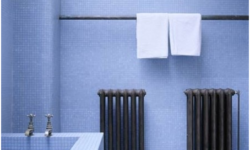The problem with germs, bacteria, microbes, etc., is that once you start thinking about them, you kind of wish you hadn’t. If you are one of those people who wipes library books with disinfecting wipes before bringing them in the house, well, let’s just say, it may also get you thinking about towels, underwear, bed sheets, and pretty much all of the everyday fabrics that are in constant close contact with our skin.
And all of this thinking leads us to the questions such as, how many times can we reuse a bath towel before we can’t be sure we’re cleaner after the shower than before we entered?

The microbiology professor Dr.Charles Gerba from the University of Arizona has carried out research into where bacteria hangs out in our daily lives, so I asked him for his input on towels. “Face towels in the bathrooms get pretty bad in terms of the number of fecal bacteria,” says Gerba, “Probably getting there after you dry your hands.”
Whoa, I don’t know if I was ready to hear that.
Let’s get straight to the tips on getting–and keeping–towels clean!
Tip #1: Flush with the Lid Down
Not enough people close the lid of the toilet before flushing, says Gerba, so tiny, unidentifiable-to-the-human-eye germs spray out from the toilet bowl onto whatever is around–including towels you have hanging neatly nearby. (He also suggests keeping your toothbrush in the medicine cabinet, or using a toothbrush cover!)
Tip #2: Change Towels Often
Most people probably wash their towels once a week. Don’t. Gerba suggests switching them out every three to four days to avoid lurking bacteria multiplying. “In damp environments the bacteria grows quickly, and in a few days you have a pretty heavy load,” says Gerba. “We found Salmonella bacteria in several of the face towels we tested, which is a major cause of diarrhea in the U.S.”
Tip #3: Wash Them Right
In a study of 60 four-person homes in Tuscon, Arizona, Dr. Gerba’s team found that one-fifth of the machines contained E. coli, while a quarter were contaminated with fecal matter! Yuck! “The laundry,” Dr. Gerba says, “is becoming less clean. Fewer Americans wash clothes and towels in hot water, and only five percent use bleach. Wash cycles are only 20 minutes, while the average drying time is only 28 minutes.” He found that some salmonella and hepatitis A survive through laundry — including the dry cycle — and remain on clothes. So wash your towels in the hottest water recommended in the care instructions, and make sure they are absolutely dry when they come out of the dryer.
In fact, all this research led Gerba to change his own laundry habits, and for squeaky clean towels, you can follow his lead for a very clean washing machine. ”I always washed my underwear last, in a separate load, but I started using bleach, and now I run an empty wash, with just bleach, when I’m done. It’s mouthwash for the machine.”
If all of this is freaking you out about your bath towels, your bathroom, and now your washing machine, not to worry: Having sampled spots all over numerous households, Dr. Gerba has found that in most cases the bathroom is much cleaner than the kitchen.
But that is a different story!
 (1)Dislikes
(1)Dislikes (0)
(0)










